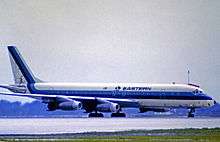Eastern Air Lines Flight 304
 A Douglas DC-8 of Eastern Air Lines, similar to the aircraft involved in the accident | |
| Occurrence | |
|---|---|
| Date | February 25, 1964 |
| Summary | Pitch Trim Failure |
| Site | Lake Pontchartrain, near New Orleans, Louisiana, USA |
| Aircraft type | Douglas DC-8 |
| Operator | Eastern Air Lines |
| Registration | N8607[1] |
| Passengers | 51 |
| Crew | 7 |
| Fatalities | 58 |
| Injuries | 0 |
| Survivors | 0 |
Eastern Air Lines Flight 304, a Douglas DC-8 flying from New Orleans International Airport to Washington Dulles International Airport, crashed on February 25, 1964. All 51 passengers and 7 crew were killed. Among the dead were American opera singer and actor Kenneth Lee Spencer and Marie-Hélène Lefaucheux, a women's and human rights activist and member of the French delegation to the United Nations.
Flight 304, which had originated in Mexico City, left New Orleans International Airport for Atlanta at 2:01 a.m., Central Standard Time, and disappeared from radar at 2:10 a.m. Visibility was good, although there was a light rain. The winds were calm. The Coast Guard and other searchers sighted the wreckage around dawn in Lake Pontchartrain, about 20 miles (32 km) northeast of New Orleans.
The subsequent investigation concluded that the jet crashed into Lake Pontchartrain en route due to "degradation of aircraft stability characteristics in turbulence, because of abnormal longitudinal trim component positions." [2]
At least 32 of the passengers were making the through trip. Fourteen got on in New Orleans, while 14 were pass-riding Eastern employees. The four-engined plane, capable of carrying 126 passengers, was due in Atlanta at 3:59 a.m., at Dulles Airport in Washington at 5:53 a.m. and at Kennedy Airport in New York at 7:10 a.m.
The victims included Marie-Hélène Lefaucheux, a member of the French delegation to the United Nations, who was active in women's and human rights activities of the world body. The pilot...with Eastern 21 years, had flown over five million miles. The co-pilot...had almost two million miles on his flight log.
Coast Guard recovered parts of the wreckage, clothing, luggage and what was described as bits of bodies from a wide spread area centered 6 miles (10 km) south of the north shore of the lake and about 4 miles (6 km) east of the 23-mile (37 km)-long Lake Pontchartrain causeway. A [United States] Coast Guard pilot said there were indications that the plane had exploded either in the air or on impact. Eastern said that the crew had made the routine checks after take-off and that no alarm had been given. An experienced Eastern pilot said the jet had probably reached a height of 16,000 feet shortly after it had got over the lake.
— The New York Times
The water was only 20 feet (6 m) deep, yet only 60 percent of the wreckage was recovered because the breakup was so extensive. The flight data recorder tape was too damaged to help the investigation. Instead, investigators used the maintenance records of the crashed aircraft and of other DC-8s, to conclude that the pilots had trimmed the horizontal stabilizer to the full nose-down position, to counter the excessive nose-up attitude that, in turn, was caused by a malfunctioning pitch trim compensator that had extended too far. Once the upset occurred, it was not possible to trim the horizontal stabilizer back to the nose-up position, because of the severe G-forces generated by the crew's pulling back on the yoke after the upset.[3]
See also
References
- ↑ "FAA Registry (N8607)". Federal Aviation Administration.
- ↑ Haines, Edgar (2000), Disaster in the Air, New York: Cornwall Books, p. 157, ISBN 0-8453-4777-2
- ↑ |CAB Aircraft Accident Report|EAL DC-8, Lake Pontchartrain, Louisiana, February 25, 1964
External links
- Accident description at the Aviation Safety Network
- http://www.ntsb.gov/aviationquery/brief.aspx?ev_id=159&key=0 NTSB Brief about the crash.